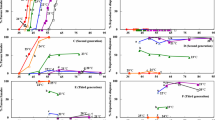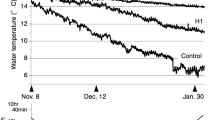Summary
-
1.
With the end of the refractory-period in November the reproductive system of the male lizard (Lacerta sicula campestris Betta) cannot be activated by 12- and 14-hours photoperiods at high temperatures. The capability of reaction grows through the winter and spontaneously reaches the threshhold in March. From than on the spermiohistogenesis begins under even unfavorable conditions (D∶D, 5–6° C).
-
2.
The incomplete endogenous reaction-capability of the reproductive system can be compensated by 16-hours photoperiods from November on after the termination of the regeneration-phase.
-
3.
With the increase of the endogenous reaction-capability the most effective photoperiod united with high temperatures shifts more and more to the shorter lightperiods and finally at the end of June only 8 or 10 hours are needed.
-
4.
If this optimal length of the photoperiod is extended, than the stimulating effect of this light-time on the reproductive system is no longer to be found, and the regressive phase sets in.
-
5.
At the end of the regeneration-phase the reproductive system can be activated by either high temperatures (28–30° C) or by the photoperiod. However it is difficult to distinguish between the influence of the high temperatures and the influence of exposure to light, because the warming effect of the lamps from 6–20 h-photoperiods is difficult to control.
-
6.
If one gives the animals permanent light or extremely short exposure periods from 4 hours coupled with 28–30° C, than the reproductive system can be stimulated only by high temperatures. In both cases the spermiohistogenetic activity reaches the same intensity, as it did during the 12- and 14-h photoperiod. In all cases the time elapsed remained the same. In those exposure-periods lying between the maximums one finds that the testis-activity is either completely inhibited or essentially weaker.
-
7.
If on the other hand one keeps male lizards with increasing photoperiods (9,30 <14 h) at only very low temperatures during December or January nevertheless one finds that the spermiohistogenetic activity begins after 4 weeks. Considering the temperature preferred by this species of lizards is 40° C, one must realise that this low temperature (5,5–9,5° C) can have little or no influence on the outcome of these experiments. The beginning of the spermiohistogenetic activity under such conditions must be mostly influenced by the photoperiods.
-
8.
A stimulation of the epididymis could not be observed in this cold-experiment. The lack of reaction in the epididymis gives evidence for the primary formation of androgen in the interstitial cells, this is because the spermiohistogenesis had already started. It cannot be decided wether the lack of secretory activity in the epididymis is the result of a failure of the ICSH to be delivered or wether the secretion of hormones in the interstitial cells is too weak.
Zusammenfassung
-
1.
Mit dem Ende der Refraktärperiode im November ist das Fortpflanzungssystem der männlichen Ruineneidechse (Lacerta sicula campestris Betta) nicht sofort wieder voll reaktionsbereit für 12- und 14stündige Photoperioden bei hohen Temperaturen. Die Reaktionsbereitschaft nimmt vielmehr langsam im Laufe des Winters zu und erreicht im März spontan eine Schwelle, von der an die Spermiohistogenese auch unter ungünstigsten Bedingungen (Dauerdunkel, 5–6° C) anläuft.
-
2.
Die mangelnde endogene Reaktionsbereitschaft des Fortpflanzungssystems kann von November an nach Beendigung der Regenerationsphase durch einen 16stündigen Langtag ausgeglichen werden.
-
3.
Mit der Zunahme der endogenen Reaktionsbereitschaft verschiebt sich die optimale Wirksamkeit der Photoperioden in Verein mit hohen Temperaturen mehr und mehr nach den kürzeren Lichtzeiten und liegt schließlich im Juni bei 8 und 10 Std.
-
4.
Überschreitet die Photoperiode bei einer bestimmten endogenen Reaktionsbereitschaft des Hypophysen-Gonaden-Systems den optimalen Wert um 2–4 Std, so schlägt die fördernde Wirkung der Tageslänge in eine hemmende um, und die Regressionsphase setzt ein.
-
5.
Im Anschluß an die Regenerationsphase kann bei einer vorzeitigen Aktivierung im Winter das Fortpflanzungssystem einerseits durch hohe Temperaturen (28–30° C) und andererseits durch die Photoperiode gesteuert werden. Dabei sind die jeweiligen Anteile von Temperaturen und Photoperioden an der Gonadenstimulation in Lichtzeiten von 6–20 Std nicht ohne weiteres voneinander zu trennen, da die Strahlungswärme der Lampen nur schwer zu erfassen ist.
-
6.
Bietet man den Tieren jedoch Dauerlicht oder eine extrem kurze Photoperiode von nur 4 Std bei 28–30° C, so wird jetzt das Fortpflanzungssystem nur noch durch die Temperatur beeinflußt. In beiden Fällen erreicht die spermiohistogenetische Aktivität dieselbe Intensität, wie in den zu dieser Zeit besonders wirksamen 12- und 14-stündigen Photoperioden. In den dazwischenliegenden Lichtzeiten ist die Hodenaktivität entweder völlig gehemmt oder doch wesentlich schwächer.
-
7.
Hält man andererseits Ruineneidechsen im Dezember in stufenweise verlängerten Photoperioden (9,30<14 h) bei sehr niedrigen Temperaturen (5,5–9,5° C), so setzt trotzdem in 4 Wochen die Spermiohistogenese ein. Da die Vorzugstemperatur bei dieser Eidechsenart bei etwa 40° C liegt, kann die Umgebungstemperatur in diesen Kaltversuchen keine oder doch nur eine sehr untergeordnete Rolle gespielt haben. Die Auslösung der spermiohistogenetischen Aktivität muß damit unter solchen Bedingungen in erster Linie auf den Einfluß der Photoperiode zurückgeführt werden.
-
8.
Eine Stimulierung des Nebenhodens war in diesen Kaltversuchen nicht zu beobachten. Da die Spermiohistogenese jedoch angelaufen war, spricht das Ausbleiben einer Reaktion im Nebenhoden für eine primäre Bildung der Androgene in den Leydigschen Zwischenzellen. Es kann dabei nicht entschieden werden, ob das Ausbleiben der sekretorischen Aktivität im Nebenhoden auf eine fehlende Abgabe des ICSH oder auf eine zu schwache Hormonproduktion im Interstitium zurückzuführen ist.
Similar content being viewed by others
Literatur
Ammon, R., u. W. Dirscherl: Fermente, Hormone, Vitamine, Bd. II: Hormone. Stuttgart: Georg Thieme, 1960.
Annan, O.: Experiments on photoperiodic regulation of the testis cycle in two species of the trush genus Hylocichla. Auk 80, 166 (1963).
Bartholomew, G. A.: The effects of artificially controlled temperature and day length on gonadal development in a lizard, Xantusia vigilis. Anat. Rec. 106, 49 (1950).
- The modification by temperature of the photoperiodic control of gonadal development in the lizard Xantusia vigilis. Copeia 1953, 45.
Burger, J. W.: The effect of photic and psychic stimuli on the reproductive cycle of the male Starling, Sturnus vulgaris. J. exp. Zool. 124, 227 (1953).
Fischer, K.: Untersuchungen zur Physiologie des Sexualverhaltens bei männlichen Ruineneidechsen (Lacerta sicula campestris Betta): Refraktärperiode und endogener Jahresrhythmus. In: Biologische Rhythmen. Nachr. Akad. Wiss., Göttingen, II. Math.-Phys. Kl. 1967, 119.
—: Untersuchungen zur Jahresperiodik der Fortpflanzung bei männlichen Ruineneidechsen (Lacerta sicula campestris Betta). Verh. Dtsch. Zool. Ges., Heidelberg 1967. Zool. Anz. 31. Suppl.-Bd., 325 (1968).
—: Untersuchungen zur Jahresperiodik der Fortpflanzung bei männlichen Ruineneidechsen (Lacerta sicula campestris Betta). I. Die Refraktärperiode. Z. vergl. Physiol. 60, 244 (1968).
Herter, K.: Über Vorzugstemperaturen von Reptilien. Z. vergl. Physiol. 28, 106 (1941).
Licht, P.: Environmental control of annual testicular cycles in the lizard Anolis carolinensis I. Interaction of light and temperature in the initiation of testicular recrudescence. J. exp. Zool. 165, 505 (1967a).
—: Environmental control of annual testicular cycles in the lizard Anolis carolinensis II. Seasonal variations in the effects of photoperiod and temperature on testicular recrudescence. J. exp. Zool. 166, 243 (1967b).
Lofts, B., and C. J. F. Coombs: Photoperiodism and the testicular refractory period in the Mallard. J. Zool. 146, 44 (1961).
Marshall, A. J.: Internal and environmental control of breeding. Ibis J. Zool.101, 456 (1959).
Miller, A. H.: The refractory period in light-induced reproductive development of golden-crowned sparrows. J. exp. Zool. 109, 1 (1948).
—: The occurrence and maintenance of the refractory period in crowned sparrows. Condor 56, 13 (1954).
Vaugien, L.: Influence de l'obscuration temporaire sur la durée de la phase réfractaire du cycle sexuel du moineau domestique. Bull. biol. France et Belg. 88, 294 (1954).
Wolfson, A.: The occurrence and regulation of the refractory period in the gonadal and fat cycles of the Junco. J. exp. Zool. 121, 311 (1952).
—: Role of light and darkness in the regulation of the refractory period in the gonadal and fat cycles of migratory birds. Physiol. Zool. 33, 160 (1959).
—: Regulation of annual periodicity in the migration and reproduction of birds. Cold Spr. Harb. Symp. quant. Biol. 25, 507 (1960).
Author information
Authors and Affiliations
Additional information
Mit Unterstützung der Deutschen Forschungsgemeinschaft (Fi 78/5+6).
Diese Arbeit ist ein weiterer und ergänzter Teil meiner Habilitationsschrift, die ich am 19. 10. 1967 der Math.-Nat. Fakultät der Georg August-Universität zu Göttingen vorlegte.
Rights and permissions
About this article
Cite this article
Fischer, K. Untersuchungen zur Jahresperiodik der Fortpflanzung bei männlichen Ruineneidechsen (Lacerta sicula campestris Betta). Z. Vergl. Physiol. 61, 394–419 (1968). https://doi.org/10.1007/BF00297873
Received:
Issue Date:
DOI: https://doi.org/10.1007/BF00297873




